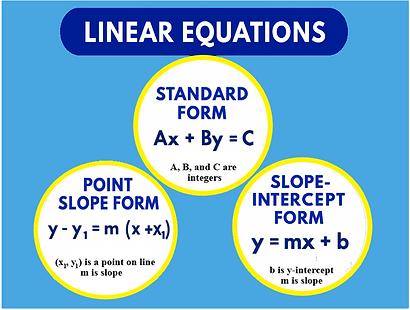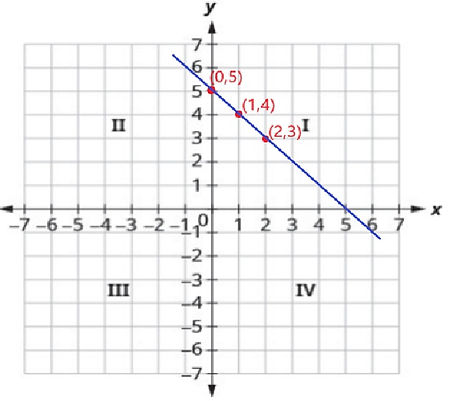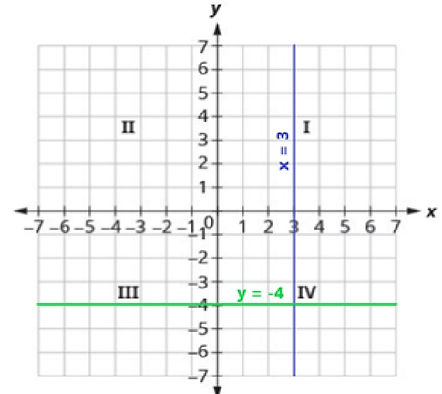
Linear Equations Made Simple
Easy Techniques to Solve Linear Equations in 1 and 2 variables
Linear equations are fundamental mathematical expressions that establish relationships between variables. Understanding linear equations is crucial for solving real-world problems and mastering algebraic concepts. Meet expert online algebra tutors to grasp the essential principles of linear equations with clear explanations, examples, and practice tests and quizzes.


What are the prerequisites to learn Linear Equations?
Before a student starts to learn linear equations in algebra, it helps if they have some foundational math skills in place.
Here are the main prerequisites: Number Sense & Arithmetic, PEMDAS, Properties of Numbers, Factors and Multiples, GCF, LCM, Variables & Simple Expressions.
What are Linear Equations?
Linear equations are algebraic equations that represent the relationship between one or more variables having highest power 1.
They are called linear because they form a straight line when graphed.
Examples of linear equations:
2x - 1 = 0 (One variable linear equation)
x + y = 4 (Two variable linear equation)
.What are the terminologies used in a linear equation?
If we have a linear equation: 3x + 5y = 1
x, y are the variables.
1 is the constant
3 is coefficient of x
5 is coefficient of y
+, - are the operators
Degree of the variable in the equation is 1.
It is the highest power of the variable in the expression is 1.
What are the different forms of Linear Equations?
-
Standard form: Ax + By = c ( where A, B, C are the real numbers)
-
Slope intercept form: y = mx + c
(where m is the slope and c is the y-intercept)
-
Point slope form: y - y1 = m(x - x1)
(where (x1, y1) is a point on the line and m is the slope)
Note: Slope in a linear equation is the amount of steepness of the line.
Slope of a line is represented by the letter 'm'.
How to find the slope of a line?
-
When two points on the line are given:
Slope can be found out using formula:
Slope (m) = rise/run = (y2 - y1)/(x2 - x1)
(where (x1, y1) and (x2, y2) are points on the line)
Example: Two points on a line are (3, -2) and (4, 1)
Slope (m) = (1- (-2))/(4-3) = 3
2. When equation of a line is given:
Convert the given equation in slope-intercept form (y = mx + c),
where m is the slope of line.
-
Example: 2x + 3y = 6
3y = - 2x + 6 (Subtract 2x on both side)
y = -2/3x + 6/3 (Divide 3 on both side)
y = -2/3x + 2
Comparing the above equation with the slope-intercept form (y = mx + c)
m = -2/3
3. When graph of a line is given:
Step 1: Take two points on line such that the coordinates of points are integers.
Then find slope using formula m = (y2 - y1)/(x2 - x1) (where (x1, y1) and (x2, y2) are the points on the line)
Or
Find out the slope (rise over run) between two points on the line (one of the points can be the x or y-intercept)
Example:
Two points on the line are (0, 1) and (3, 3)
Slope (m) = (y2 - y1)/(x2 - x1) = (3 - 1)/(3 - 0) = 2/3
Or
Slope (m) = rise of 2 units/run of 3 units = 2/3
How to find the equation of a line?
-
When y-intercept and slope of the line is given:
Using the slope intercept form of equation:
y = mx + c, where m is the slope and c is the y-intercept
Substitute the values of slope and y-intercept in the equation
Example: slope = -2, y-intercept = 5
Equation of line: y = -2x + 5
2. When two points that lie on the line is given:
Using point-slope form of equation :
y-y1 = m(x - x1) (where (x1, y1) is a point on the line and m is the slope)
Example: Two points on the line are (3, -2) and (4, 1).
Step 1: Find slope using formula slope
m = (y2 - y1)/(x2 - x1) (where (x1, y1) and (x2, y2) are the points on the line)
m = (1-(-2))/(4-3) = 3
Step 2: Taking any of the given point and slope, let us substitute values in point-slope form of equation.
y - 1 = 3 (x - 4)
y – 1 = 3x – 12 (adding 1 on both sides)
y = 3x – 11
3. When a point and slope is given:
Using point-slope form of equation as given in above example
4. When graph of the line is given:
Example:
Step 1: Identify the y-intercept (the point where the line intersects y-axis),
which is 1 in the given graph
Step 2: Identify slope using formula,
m = rise/run = (y2 - y1)/(x2 - x1)
(where (x1, y1) and (x2, y2) are the points on the line)
m = 2/3
Step 3: Substitute the value of slope in Slope-intercept form of equation
y =2/3 x + 1
What is the slope of a line parallel to the given line?
The slopes of two parallel lines are always equal.
Example: if line l || m, the slope of line l is ¼, then the slope of line m will also be 1/4
What is the slope of a line perpendicular to the given line?
If slope of a given line is m, then the slope of a line perpendicular to it is -1/m (the product of their slopes is -1).
Example: Given that line p ⊥ n (they intersect at 90 degrees).
If slope of line p is ¼, then slope of line n = - ( 1/1/4) = - 4 (negative 4)





Graphing Linear Equations in one or two variables:
Graphing linear equations is a visual way to represent the relationship between two variables. A linear graph is a straight line that shows how the value of one variable changes in relation to the other variable.
How can Linear equations be graphed?
There are several techniques for graphing linear equations, like
-
Finding the x and y coordinates
-
Using the slope intercept form, and
-
Using the point slope form.
-
Linear equation in one variable
1. Plotting the points:
To graph a linear equation, we can find the x and y coordinates for several points and plot them on a graph.
You can choose values of x as 0,1,2; substitute each these x-values into the given equation to find corresponding values of y.
Example: x + y = 5
To graph this linear equation, let's consider x = 0,1,2.
Step 1: When x = 0
0 + y = 5 (substitute value of x = 0 in the given equation)
y = 5
Point (0, 5) lies on the line x + y = 5 and is the y-intercept
When x = 1, (substitute value of x = 1 in the given equation)
1 + y = 5
y = 4 ( by subtracting 1 on both sides)
Point (1, 4) lies on the line
Lastly x = 2, (substitute value of x = 2 in the given equation)
2 + y = 5
y = 3 (by subtracting 2 on both sides)
Point (2, 3) lies on the line
Step 2: Plot the points (0, 5), (1, 4) and (2, 3), join them using ruler.
The line obtained is the graph of the equation x + y = 5
2. Graphing a line using its slope-intercept form:
To plot a line using its slope (m) and y-intercept (b) from an equation
such as y = mx + b, start by marking the y-intercept on the y-axis.
This point will be (0, y)
Next, apply the slope (rise/run) to determine a second point:
from the y-intercept, move up (or down) by the rise and then
move right (or left) by the run.
Finally, draw a line that connects these points.
Example: y - 1 = 2x
Step 1:
Convert the given equation in to slope-intercept form
y = mx + c, where m is the slope and c is the y-intercept
y – 1 = 2x
y = 2x + 1 (adding 1 on both sides)
Step 2:
Compare the equation with slope-intercept form
Slope (m) = 2 and y-intercept = 1
Step 3: Mark a point called y- intercept (0, 1)
(where the line intersects the y-axis with x-coordinate=0) on the graph
Step 4: Mark another point using the slope
by counting 2 units for the rise and 1 unit for the run
Step 5: Join the two points to get the graph of y-1 = 2x
3. The x- and y-intercept method:
Find the points where the line crosses the x-axis and the y-axis.
Draw a line through them.
Example: 3x + 2y = 12
Step 1: Find the x-intercept (a point where the line intersects the x-axis)
Substitute y = 0 in the equation (All points on the x-axis have
y-coordinate = 0)
3x + 2(0) = 12
3x = 12
x = 4
The x-intercept is a point (4, 0)
Step 2: Find the y-intercept (a point where the line intersects the y-axis)
Substitute x = 0 in the equation
(All points on y-axis have x-coordinate = 0)
3(0) + 2y = 12
2y = 12
y = 6
The y-intercept is a point (0, 6)
Step 3: Plot the x-intercept and y-intercept on the graph and join them
4. Linear equation in one variable:
Graph of a Linear equation in one variable is either parallel
to the x-axis or the y-axis.
Example 1: x = 3
All the points that have their x-coordinate as 3 and have
multiple values of y, lie on the line x = 3
Example 2: y = - 4
All the points that have y-coordinate as -4 and have
multiple values of x, lie on the line y = - 4
Solving Linear Equations
A solution to a linear equation is the value of the variable that satisfies the equation and makes the equation true.
How to solve a linear equation in one variable?
A general strategy for solving linear equations in one variable is simplifying the equation by combining like terms, distributing, and isolating the variable. It is important to check the answer by substituting the solution you found back into the original equation. If the left side of the equation equals the right side, your solution is correct.
Example: 2(x-1) - 2 = 3(2x + 3) + 1
Step 1: Simplify each side of equation Using distributive property
2x - 2 - 2 = 6x + 9 + 1
2x - 4 = 6x + 10
Step 2: isolating the variables by subtracting 6x on both sides and adding 4 on both sides.
2x - 4 - 6x + 4 = 6x + 10 - 6x + 4
Step 3: Combining like terms
-4x = 14
x = - 14/4 (Dividing by -4 on both sides)
x = -7/2
You can use an algebra calculator to solve linear equations and a graphing calculator to graph linear equations.
What is the solution for the system of linear equations?
The solution for a system of linear equations is the set of values for the variables that satisfy all the equations in the system simultaneously. There are three possible types of solutions for a system of linear equations:
1. Unique Solution: The system has a single solution (a point) where the lines intersect at a single point and all the variables take specific values that satisfy all the equations.
Note: A unique solution can be found if the number of equations is equal to the number of variables.
2. No Solution: The system has no solution when the equations are inconsistent, meaning they represent parallel lines or planes that do not intersect.
3. Infinite Solutions: The system has infinitely many solutions when the equations are dependent and represent overlapping lines or planes. In this case, the variables can take any values that satisfy the equations.
What are the techniques for solving system of two linear equations in two variables?
To solve a system of two linear equations in two variables, various techniques can be used, including elimination, substitution, matrix operations and graphing.
1. Solving system of Linear Equations by Elimination:
This is an algebraic method that involves adding or subtracting the two equations to cancel out or "eliminate" one of the variables.
Example: 4x + 3y = 11
2x - y = 3
Step 1: To eliminate one of the variables, add or subtract the equations. In this case let’s eliminate “x”. For this we need to multiply equation 2 by “2” to make the coefficients of x equal. Then the equation 2 becomes 4x-2y = 6
4x + 3y = 11 (Eq. 1)
4x - 2y = 6 (Eq. 2)
Step 2: Subtract eq. 2 from 1
(4x + 3y) – (4x - 2y) = 11 - 6
4x + 3y - 4x + 2y =5
5y = 5
y = 1
Step 3: Substitute this value of y into either Equation 1 or Equation 2
2x - 1 = 3 (adding 1 on both sides)
Step 4: Simplifying the equation
2x = 4 (Dividing by 2 on both sides)
x = 2
Hence, x=2, y=1 is the solution to the given system of linear equations.
2. Solving system of Linear Equations by Substitution:
In this method we isolate one variable in one equation and then substitute that expression into the other equation.
Example: 2x - 3y = 10 ( equation 1)
x+ y = 6 ( equation 2)
Step 1: Solve one equation for one variable. In this case let’s solve equation 2 for the value of x.
x = 6 - y
Step 2: Substitute it into the other equation 1 (in this case)
2(6 - y) – 3y = 10
Step 3: Expanding and simplifying the equation:
12 – 2y – 3y = 10
12 - 5y = 10
- 5y = 10 - 12 (Subtracting 12 on both sides)
- 5y = - 2 ( Divide by - 5 on both sides)
y = 2/5
x = 6 - (2/5) (Substitute value of y in equation 2)
x = 28/5
Solving system of Linear Equations by Graphing:
To solve the system of equations using the graphing method, plot given linear equations on a coordinate plane.
The point where the two lines intersect is the solution of the given linear equations.
Example: 3x + 2y = 12 -------1
2x – y = 1 ------- 2
Step 1:
Convert both the equations in the slope-intercept form
3x + 2y = 12
2y = – 3x + 12 (Subtract 3x from both sides)
y = x + 6 (Divide 2 on both sides) ------1
2x - y = 1
– y = – 2x + 1 (Subtract 2x on both sides)
y = 2x – 1 (Multiply -1 on both sides) ------2
Step 2:
Identify the slope and y-intercept of equations 1 and 2
Equation 1: slope = -3/2, y-intercept = 6
Equation 2: slope = ,2, y-intercept = – 1
Step 3:
Graph equation 1
Mark the point y-intercept A (0, 6)
Mark another point B (-3, 8) (Start from (0, 6), move 3 units down and 2 units right) using slope -3/2)
Join AB
Step 4:
Graph equation 2 on the same coordinate plane
Mark the point y-intercept P (0, -1)
Mark another point Q (1, 1)) (Start from (0, -1), move 2 units up and 1 unit right) using slope 2)
Join PQ
Step 5:
Identify the point where two lines intersect:
The point of intersection of two lines B (2, 3) is the solution to given system of equations.
Why is it important for students to learn about Linear Equations?
The importance of mastering linear equations is that they are a fundamental concept in mathematics and mastering them is crucial for success in high school math courses like Algebra 1, Algebra 2, Geometry, and Trigonometry. Additionally, understanding linear equations is essential for problem-solving in various fields, from calculating the cost of goods to designing a bridge. They are also essential in fields such as engineering, economics, and science.






